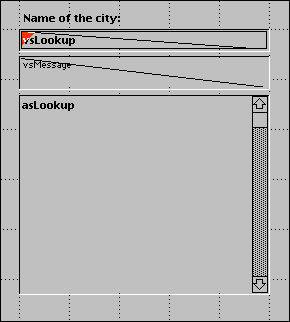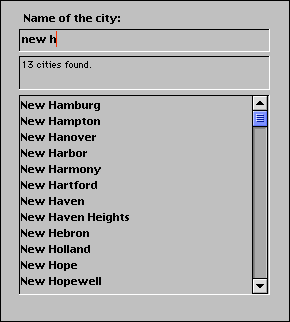4D v14.3
Keystroke
 Keystroke
Keystroke
| Keystroke -> Function result | ||||||||
| Parameter | Type | Description | ||||||
| Function result | String |

|
Character entered by user | |||||
Keystroke returns the character entered by the user into a field or an enterable area.
Usually, you will call Keystroke within a form or object method while handling an On Before Keystroke event form. To detect keystroke events, use the command Form event.
To replace the character actually entered by the user with another character, use the command FILTER KEYSTROKE.
Note: The Keystroke function does not work in subforms.
IMPORTANT NOTE: If you want to perform some “on the fly” operations depending on the current value of the enterable area being edited, as well as the new character to be entered, remember that the text you see on screen is NOT YET the value of the data source field or variable for the area being edited. The data source field or variable is assigned the entered value after the data entry for the area is validated (e.g., tabulation to another area, click on a button, and so on). It is therefore up to you to “shadow” the data entry into a variable and then to work with this shadow value. You must do so if you need to know the current text value for executing any particular actions. You can also use the function Get edited text.
You will use the command Keystroke for:
- Filtering characters in a customized way
- Filtering data entry in a way that you cannot produce using data entry filters
- Implement dynamic lookup or autocomplete areas
See examples for the command FILTER KEYSTROKE.
When you process an On Before Keystroke event, you are dealing with the editing of the current text area (the one where the cursor is), not with the “future value” of the data source (field or variable) for this area. The Handle keystroke project method allows to shadow any text area data entry into a second variable, which you can use to perform the actions while entering characters into the area. You pass a pointer to the area’s data source as the first parameter and a pointer to the shadow variable as second parameter. The method returns the new value of the text area in the shadow variable, and returns True if the value is different from it what was before the last entered character was inserted.
` Handle keystroke project method
` Handle keystroke ( Pointer ; Pointer ) -> Boolean
` Handle keystroke ( -> srcArea ; -> curValue ) -> Is new value
C_POINTER($1;$2)
C_TEXT($vtNewValue)
` Get the text selection range within the enterable area
GET HIGHLIGHT($1->;$vlStart;$vlEnd)
` Start working with the current value
$vtNewValue:=$2->
` Depending on the key pressed or the character entered,
` Perform the appropriate actions
Case of
` The Backspace (Delete) key has been pressed
:(Character code(Keystroke)=Backspace)
` Delete the selected characters or the character at the left of the text cursor
$vtNewValue:=Substring($vtNewValue;1;$vlStart-1-Num($vlStart=$vlEnd))
+Substring($vtNewValue;$vlEnd)
` An acceptable character has been entered
:(Position(Keystroke;"abcdefghjiklmnopqrstuvwxyz -0123456789")>0)
If($vlStart#$vlEnd)
` One or several characters are selected, the keystroke is going to override them
$vtNewValue:=Substring($vtNewValue;1;$vlStart-1)
+Keystroke+Substring($vtNewValue;$vlEnd)
Else
` The text selection is the text cursor
Case of
` The text cursor is currently at the begining of the text
:($vlStart<=1)
` Insert the character at the begining of the text
$vtNewValue:=Keystroke+$vtNewValue
` The text cursor is currently at the end of the text
:($vlStart>=Length($vtNewValue))
` Append the character at the end of the text
$vtNewValue:=$vtNewValue+Keystroke
Else
` The text cursor is somewhere in the text, insert the new character
$vtNewValue:=Substring($vtNewValue;1;$vlStart-1)+Keystroke
+Substring($vtNewValue;$vlStart)
End case
End if
` An Arrow key has been pressed
` Do nothing, but accept the keystroke
:(Character code(Keystroke)=Left arrow key)
:(Character code(Keystroke)=Right arrow key)
:(Character code(Keystroke)=Up arrow key)
:(Character code(Keystroke)=Down arrow key)
`
Else
` Do not accept characters other than letters, digits, space and dash
FILTER KEYSTROKE("")
End case
` Is the value now different?
$0:=($vtNewValue#$2->)
` Return the value for the next keystroke handling
$2->:=$vtNewValueAfter this project method is added to your application, you can use it as follows:
` myObject enterable area object method
Case of
:(Form event=On Load)
MyObject:=""
MyShadowObject:=""
:(Form event=On Before Keystroke)
If(Handle keystroke(->MyObject;->MyShadowObject))
` Perform appropriate actions using the value stored in MyShadowObject
End if
End caseLet’s examine the following part of a form:

It is composed of the following objects: an enterable area vsLookup, a non-enterable area vsMessage, and a scrollable area asLookup. While entering characters in vsLookup, the method for that object performs a query on a [US Zip Codes] table, allowing the user to find US cities by typing only the first characters of the city names.
The vsLookup object method is listed here:
` vsLookup enterable area object method
Case of
:(Form event=On Load)
vsLookup:=""
vsResult:=""
vsMessage:="Enter the first characters of the city you are looking for."
CLEAR VARIABLE(asLookup)
:(Form event=On Before Keystroke)
If(Handle keystroke(->vsLookup;->vsResult))
If(vsResult#"")
QUERY([US Zip Codes];[US Zip Codes]City=vsResult+"@")
MESSAGES OFF
DISTINCT VALUES([US Zip Codes]City;asLookup)
MESSAGES ON
$vlResult:=Size of array(asLookup)
Case of
:($vlResult=0)
vsMessage:="No city found."
:($vlResult=1)
vsMessage:="One city found."
Else
vsMessage:=String($vlResult)+" cities found."
End case
Else
DELETE FROM ARRAY(asLookup;1;Size of array(asLookup))
vsMessage:="Enter the first characters of the city you are looking for."
End if
End if
End caseHere is the form being executed:

Using the interprocess communication capabilities of 4D, you can similarily build user interfaces in which Lookup features are provided in floating windows that communicate with processes in which records are listed or edited.
Product: 4D
Theme: Entry Control
Number:
390
Created: 4D v6
FILTER KEYSTROKE
Form event
Get edited text
4D Language Reference ( 4D v11 SQL Release 6)
4D Language Reference ( 4D v14 R2)
4D Language Reference ( 4D v12.4)
4D Language Reference ( 4D v13.5)
4D Language Reference ( 4D v14 R3)
4D Language Reference ( 4D v14.3)
4D Language Reference ( 4D v14 R4)







